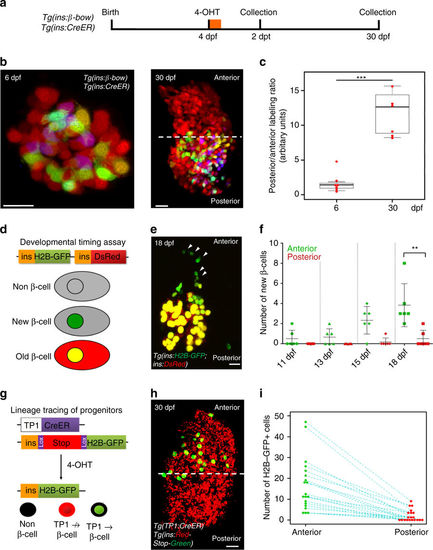Fig. 2
- ID
- ZDB-FIG-180202-36
- Publication
- Singh et al., 2017 - Different developmental histories of beta-cells generate functional and proliferative heterogeneity during islet growth
- Other Figures
- All Figure Page
- Back to All Figure Page
|
Post-embryonic and embryonic beta-cell lineages coexist in the islet?s anterior and posterior regions. a Beta-cells were labeled using beta-bow at 4?dpf and traced until 6 or 30?dpf to determine the localization of their progeny inside the islet. b Primary islets at 6 and 30?dpf. Multicolor beta-cells exhibit uniform distribution at 6?dpf. At 30?dpf, the multicolor cells localize within the islet?s posterior half. The anterior half contains un-recombined cells exhibiting red fluorescence. Dashed line marks the center of the islet?s A/P axis. c Tukey style boxplot showing quantification of the posterior/anterior labeling ratio, which measures the YFP and CFP florescence intensities in the posterior vs. the anterior half of the islet in order to determine the relative abundance of multicolor cells in each half. The 6?dpf islets exhibit similar distributions, while the 30?dpf islets contain more multicolor cells within the posterior half (n?=?6 islets at each stage) (unpaired two-tailed t-test, p???0.001). d The developmental timing assay consists of two fluorescent reporters, EGFP, and DsRed, both expressed under the insulin promoter. The relatively faster maturation of GFP compared to DsRED allows to transiently mark the recently formed beta-cells with only green fluorescence, and to distinguish them from older beta-cells, which express both colors. e A primary islet from Tg(ins:H2B-GFP; ins:DsRed) animals at 18?dpf. A streak of recently formed cells is present near the islet?s anterior side (arrowheads). f Time course of recently differentiated beta-cells from 11?18?dpf, showing an increase in their numbers preferentially in proximity to the islet?s anterior region at 18?dpf (n?=?6 islets per time point) (paired two-tailed t-test, **p???0.01). Plot shows the ?mean?▒?S.D. g The Tp1 promoter drives Cre-ERT2-expression in NRCs. CRE-mediated recombination excises the floxed mCherry in NRCs. NRCs that undergo successful recombination and subsequent beta-cell differentiation, activate insulin:H2B-GFP-expression. h Tg(Tp1:Cre-ER T2 ); Tg(ins:Red-Stop-Green) animals were treated with 4-OHT at 4?dpf. Beta-cells differentiating from NRCs exhibit H2B-EGFP expression at 30?dpf. Dashed line marks the center of the islet?s anterior?posterior axis. Note that Tg(Tp1:Cre-ER T2 ) can mark ~30% of the NRCs, hence, the beta-cells that differentiate from NRCs are under-represented. i Number of H2B-EGFP-positive beta-cells within the anterior and posterior halves of individual islets (blue dotted line) at 30?dpf. All islets show an anterior bias in beta-cell differentiation (n?=?20 islets). Scale bars, 20?Ám |
| Genes: | |
|---|---|
| Fish: | |
| Anatomical Terms: | |
| Stage Range: | Prim-5 to Protruding-mouth |

